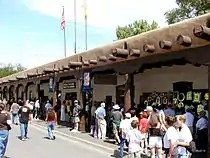Palace of the Governors
The Palace of the Governors (Spanish: Palacio de los Gobernadores) (1610) is an adobe structure located on Palace Avenue on the Plaza of Santa Fe, New Mexico, between Lincoln Avenue and Washington Avenue. It is within the Santa Fe Historic District and it served as the seat of government for the state of New Mexico for centuries. The Palace of the Governors is the oldest continuously occupied public building in the United States.
Palace of the Governors | |
 Palace of the Governors | |
| Location | 120 Washington Avenue, Santa Fe, New Mexico |
|---|---|
| Coordinates | 35°41′16″N 105°56′15″W |
| Area | less than one acre |
| Built | 1610 |
| Architectural style | Colonial, Spanish-Pueblo |
| Part of | Santa Fe Historic District (ID73001150[1]) |
| NRHP reference No. | 66000489[1] |
| NMSRCP No. | 17 |
| Significant dates | |
| Added to NRHP | October 15, 1966 |
| Designated NHL | October 9, 1960[2] |
| Designated CP | July 23, 1973 |
| Designated NMSRCP | September 29, 1972 |
History
In 1610, Pedro de Peralta, the newly appointed governor of the Spanish territory covering most of the American Southwest, began construction on the Palace of the Governors, although recent historical research has suggested that construction began in 1618.[3] In the following years, the Palace changed hands as the territory of New Mexico did, seeing the Pueblo Revolt of 1680, the Spanish reconquest from 1693 to 1694, Mexican independence in 1821, and finally American possession in 1848. The Palace originally served as the seat of government of the Spanish colony of Nuevo Mexico, which at one time comprised the present-day states of Texas, Arizona, Utah, Colorado, Nevada, California, and New Mexico. After the Mexican War of Independence, the Mexican province of Santa Fe de Nuevo México was administered from the Palace of the Governors. When New Mexico was annexed as a U.S. territory, the Palace became New Mexico's first territorial capitol.
Lew Wallace wrote the final parts of his book Ben-Hur: A Tale of the Christ in this building while serving as territorial governor in the late 1870s. He remembered later in life that it was at night, during a severe thunderstorm in the spring of 1879, after returning from a tense meeting with Billy the Kid in Lincoln County, when he wrote the climactic Crucifixion scenes of the novel. Wallace worked by the light of a shaded lamp in the shuttered governor's study, fearing a bullet from outside over the tensions surrounding the Lincoln County War.
In 1909 anthropologist Dr. Edgar Lee Hewett invited the young archeologist Jesse L. Nusbaum to oversee the restoration of the Palace of the Governors that had fallen into disrepair. For this assignment, which was completed in the Fall of 1913, Jesse L. Nusbaum was hired as the first employee of the Dr. Edgar Lee Hewett led School of American Archaeology, later the School of American Research, and Museum of New Mexico in Santa Fe, New Mexico. In his journal, Nusbaum stressed the importance of melding the Palace architecture with the environment, noting that “the Palace was begun with an adaptation to climate and atmosphere and had been fitted into the color of earth and sky.”, a view he later applied again as Superintendent of Mesa Verde National Park.[4]
Between 1909, when the New Mexico territorial legislature established the Museum of New Mexico, and Summer 2009 the Palace of the Governors served as the site of the state history museum. In 2009 the New Mexico History Museum was opened adjacent to the Palace, which is now one of eight museums overseen by the New Mexico Department of Cultural Affairs.
It was declared a National Historic Landmark in 1960.[2][5]
The United States Postal Service issued a turquoise 1¼-cent stamp on June 17, 1960 featuring an image of the Palace. According to Steven J. Rod, "This was in coincidence with the opening day of Santa Fe’s 350th anniversary celebration. The Palace is shown on the stamp from a front angle, a design which was taken from a photograph by Tyler Dingee of Santa Fe. The Governor's Palace stamp was the eighth 'national shrine' honored by this series."[6]
See also
| External video | |
|---|---|
 | |
References
- "National Register Information System". National Register of Historic Places. National Park Service. July 9, 2010.
- "National Historic Landmarks Survey, New Mexico" (PDF). National Park Service. Retrieved January 7, 2017.
- Roberts, Kathaleen (16 February 2012). "New Palace story emerges". Albuquerque Journal. Albuquerque, New Mexico, USA.
New Mexico State Historian Rick Hendricks has discovered that the nation’s oldest continuously occupied public building may have been constructed in about 1618 –– and by a different governor.
- Nusbaum, Rosemary: ”The City Different and the Palace: The Palace of the Governors and its Role in Santa Fe History, including Jesse Nusbaum’s Restoration Journals”. The Sunstone Press, Santa Fe, 1978, ISBN 0913270792
- Corinne P. Sze and Patti Henry (1999). "National Historic Landmark Inventory/Nomination: Palace of the Governors" (pdf). National Park Service. Cite journal requires
|journal=(help) and Accompanying photos, exterior and interior, from 19 (32 KB) - 1 1/4-cent Palace of the Governors. Steven J. Rod.
- "New Mexico's Palace of the Governors". C-SPAN. January 7, 2013. Retrieved March 16, 2013.
External links
| Wikimedia Commons has media related to Palace of the Governors. |
- Palace of the Governors Museum - housed in the Palace of the Governors building
- New Mexico History Museum official website
- Palace of the Governors Photo Archives